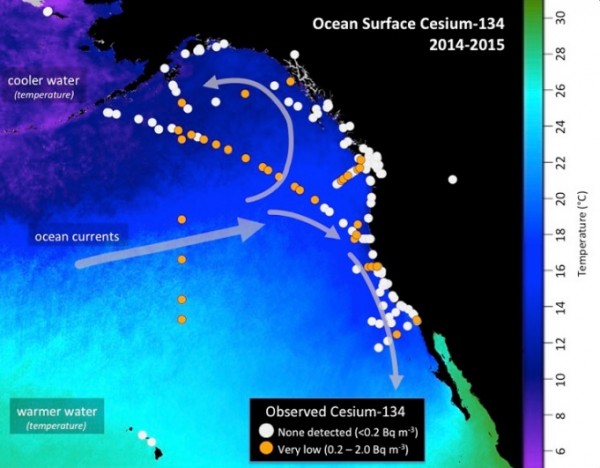By Ana Verayo, | December 12, 2016

Map shows the location of seawater samples taken by scientists and analyzed at the Woods Hole Oceanographic Institution for radioactive cesium. (Jessica Drysdale, Woods Hole Oceanographic Institution)
Scientists have detected radiation across Oregon off the Pacific Ocean originating from the Fukushima nuclear power plant disaster in Japan in 2011. This radioactive material is headed towards the United States at an estimated 6,000 miles distance.
Like Us on Facebook
This radioactive material consists of an isotope called cesium-134. Scientists detected it off Tillamook Bay around 50 miles off Portland and also in Gold Beach some 250 miles off the northwestern coast of Oregon.
The radioactive material was released from a wave of devastating tsunamis that hit Japan's eastern coast, killing at least 15,000 people. Scientists say that it was the largest earthquake that hit Japan in 140 years, generating 10 meter waves, wiping out coastal cities and communities in the region.
These tsunamis also hit a nuclear reactor at the Fukushima Daiichi power plant, releasing several radioactive isotopes such as very toxic fission products like cesium-137 and iodine-131. This resulted in air and water contamination, forcing 160,000 locals to evacuate these areas.
According to researchers at the Woods Hole Oceanographic Institution, this radioactive material headed for the US possesses extremely low levels and apparently do not pose any dangers to human life or the environment.
Apart from the Woods Hole Oceanographic Institution, the Fukushima InFORM project of the University of Victoria is also monitoring this radiation from across the Pacific ocean. Researchers have additionally revealed that cesium-134 was also detected in Canadian salmon found in northern Oregon.
Many fish species apparently possess these radioactive isotopes, as they were exposed to this toxic material from the Fukushima Daiichi nuclear disaster. Cesium-134 was also detected in albacore tuna. While the presence of this isotope is increasing in the central northeastern Pacific, it is at levels that pose no threat at the moment, says chemical oceanographer Ken Buesseler of the Marine Chemistry & Geochemistry Department, Woods Hole Oceanographic Institution.
-
Use of Coronavirus Pandemic Drones Raises Privacy Concerns: Drones Spread Fear, Local Officials Say

-
Coronavirus Hampers The Delivery Of Lockheed Martin F-35 Stealth Fighters For 2020

-
Instagram Speeds Up Plans to Add Account Memorialization Feature Due to COVID-19 Deaths

-
NASA: Perseverance Plans to Bring 'Mars Rock' to Earth in 2031

-
600 Dead And 3,000 In The Hospital as Iranians Believed Drinking High-Concentrations of Alcohol Can Cure The Coronavirus

-
600 Dead And 3,000 In The Hospital as Iranians Believed Drinking High-Concentrations of Alcohol Can Cure The Coronavirus

-
COVID-19: Doctors, Nurses Use Virtual Reality to Learn New Skills in Treating Coronavirus Patients







